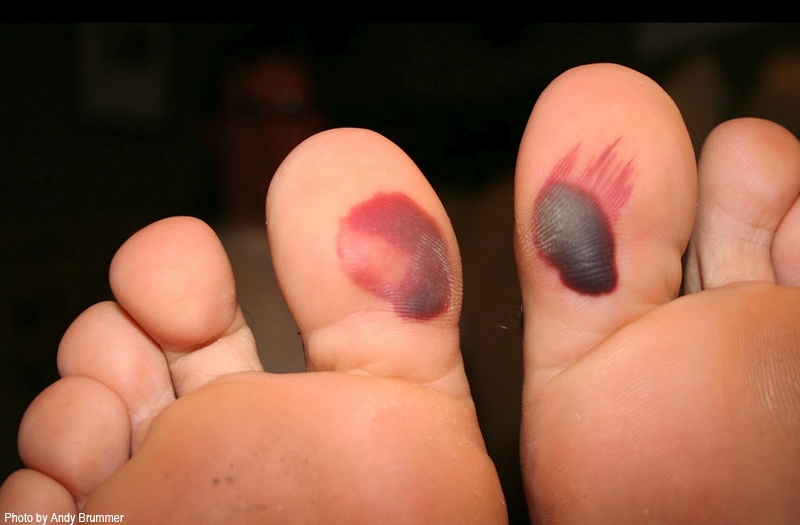You are viewing 1 of your 1 free articles. For unlimited access take a risk-free trial
Lockdown training: how to avoid an ear bashing
With many forced to train indoors due to lockdowns, motivational music is more important than ever to keep the spirits up. But as Andrew Hamilton explains, athletes who frequently use headphones while training should choose wisely to ensure good ear health
As a keen music lover, the advent of music on the move thanks to MP3 players and mini headphones was revelation for me. No more long and dreary training sessions when I wasn’t in the mood. It was on with the headphones, cue the music and I was fired up no matter how I’d been feeling beforehand. Initially, I was in training heaven. Long indoors winter sessions with my favourite music beautifully reproduced and piped directly into my ears seemed to just fly by. However, after a 3-week period of particularly intense headphone use, I noticed the inside of my right ear had become itchy. Scratching it only seemed to make things worse and the itchiness soon turned into discomfort. A couple of days later, the discomfort had evolved into a nagging throbbing pain that kept me awake at night so I reluctantly consulted my doctor. He instantly diagnosed a condition known as ‘otitis externa’ (sometimes referred to as ‘swimmer’s ear’) and prescribed an antibiotic spray, which thankfully resolved the (very painful) condition.In-ear headphone use and otitis externa
Otitis externa is a condition in which the ear canal becomes infected (see box 1 and figure 1 for more detail). The use of in-ear headphones (ie with buds) however significantly increases the risk of otitis externa. Not only can the headphone tips damage the skin in the ear canal as you insert or adjust them to get a good ‘fit’, they can also pick up pathogenic bacteria which are then also inserted into the ear canal. This can easily happen for example if you allow them to dangle down from your MP3 player, enabling the tips to make contact with surfaces that might be carrying bacteria – a particular hazard even in the cleanest gym!Box 1: What is otitis externa?
Otitis externa is an inflammation of the outer ear canal - the tube between the skin surface of the external ear and the eardrum (see figure 1). Typical symptoms include redness and swelling of the skin of the ear canal and itchiness, especially in the early stages. As it progresses, the ear can become sore and painful. There may also be a discharge, or increased amounts of earwax, and if the ear canal becomes blocked by swelling or secretions, hearing can be affected.Otitis externa is usually caused by an infection, which may be fungal or bacterial. A bacterial infection is more likely to result in a localised problem, such as an inflamed spot or boil in the ear canal, but can cause more widespread inflammation of the tissues. Otitis externa may also develop in skin conditions such as eczema or dermatitis, where there's no infection but generalised inflammation of the skin.
Anyone can develop otitis externa and it often follows localised trauma to the skin of the ear canal - for example, if objects are placed in the ear, or if the canal is scraped by a cotton-tipped bud in an attempt to remove earwax. Constantly getting the ears wet can also damage the normal immune defences in the ear leading to infection (hence the term swimmer's ear). Studies also indicate that once you’ve suffered one episode of otitis externa, you’re more likely to suffer a subsequent episode – something that the author can (unfortunately) attest to!
Figure 1: Structure of the ear

Otitis externa affects the ear canal, which as this diagram shows, is the tube connecting the visible part of the ear (ie outside the head) to the eardrum of the middle ear.
To make matters worse, in-ear headphones effectively form an air-tight seal within the ear canal. Even at rest, this increases humidity, encouraging bacterial growth. However, increased humidity is of course even more of a problem when exercising with in-ear headphones inserted when heat and sweat are inevitable. A number of medical professionals now believe that the explosion in popularity of in-ear headphones is leading to a significant increase in the incidence of otitis externa in otherwise healthy individuals with no previous history of ear infections [Vestn Otorinolaringol. 2019;84(3):46-50] (see box 2).
Myles Black is a consultant and surgeon specialising in ear nose and throat (ENT) medicine, Programme Director for ENT training in Northern Ireland and a full-time NHS Consultant ENT & Thyroid Surgeon working in the Royal Victoria Hospital, Belfast (mylesblack.com/home). I asked for his thoughts on headphone use and otitis externa. I started by asking him about the link between in-ear headphone use and otitis externa. He explained: “It’s well known in ENT that when we are managing patients with hearing aids we have to advise them that they are at increased risk of otitis externa because the ‘in the ear canal’ part of the hearing aid may help to cause infection directly either by an allergenic effect or indirectly by limiting ventilation of the ear canal. This then becomes moist and an ideal breeding ground for pathogenic bacteria.”
He also explained that in-ear headphone use becomes more hazardous when combined with exercise (which involves sweating): “It logically makes sense that if a moist, warm environment is provided over a period of time then this micro-environment stands a higher chance of being colonized by bacteria or fungi than those ears which remain dry and clean.”
So what measures does he recommend to prevent the occurrence or reoccurrence of otitis externa? “The best advice is to quite simply limit the amount of time that an ear canal is completely occluded (ie to minimize in-ear headphone use) and to use simple solutions to wax blockage such as topical olive and almond oil when required. These measures will help to ensure the canal remains clean and dry. I would also recommend that patients who have experienced problems with ear infections in the past while using in-ear headphones switch to normal ‘over-ear’ headphones for use during exercise instead of in-ear types.”
Protect yourself
By no means will all in-ear headphone users go on to suffer otitis externa. As with any medical condition, individual susceptibility plays a major role. However, the greater the frequency and duration of in-ear headphone use, the greater the risk of an infection. The good news for in-ear headphone fans is that there are a number of preventative steps that can be taken to reduce this risk. These are as follows:- #Experiment with different headphone tips to ensure you get a good fit without having to either force the tip into the ear canal or constantly readjust it once it has been inserted.
- #Keep your headphone tips scrupulously clean – use antibacterial alcohol wipes before and after every training session.
- #Change your old headphone tips (which can accumulate bacteria) for new ones regularly.
- #Never allow your headphones to dangle down and touch surfaces that could harbor bacteria before inserting them into your ears. Be particularly careful when using them in shared environments such as the gym.
- #Consider using an acidifying ear spray product (such as ‘Earcalm’or an equivalent product - one containing acetic acid) before in-ear headphone use. These products temporarily enhance the ear canal’s natural acidity, inhibiting any bacterial growth;
- #After hair washing, thoroughly dry your ears using a hairdryer on a low, cool setting.
- #Never insert cotton wool buds or other objects into your ears. Wax works its way out naturally and cotton buds should only be used to sweep around your outer ear (pinna). If earwax build-up is a problem, have it removed by a healthcare professional.
However, an even better solution is to consider ditching in-ear headphones completely and switching to a conventional ‘over-ear’ design. Although they’re a lot bulkier (and therefore less discreet looking), over-ear headphones solve two main problems at a stroke: a) they don’t involve sticking a foreign object into the ear canal and b) they make it easier for the ear canal to breathe, thus reducing the build up of humidity.
Because an MP3 player only has a small power output, you’ll need to ensure that any over-ear headphones are sufficiently sensitive (ie can be driven to a reasonable volume level by your MP3 player/mobile phone/iPod etc). However, there are plenty of top quality sounding headphones out there from manufacturers such as Sony, Sennheiser, Grado etc that will be compatible. There are also other designs with an even more open design (allowing to ear to breathe) such as the ‘AfterShokz’ heaphones (aftershokz.com/ - figure 2), which uses a small driver placed just in front of the ear, sending mini vibrations through the cheekbones to deliver sound directly to the inner ear, bypassing the eardrum. In this and other such designs, there’s absolutely no obstruction to the ear canal, which therefore breathes completely freely.
Figure 2: AfterShokz 'bone conduction' earphones*

A small driver placed just in front of the ear, sends mini vibrations through the cheekbones to deliver sound directly to the inner ear. (*photo courtesy of AfterShokz)
In summary
Your ears are amazing precision structures and accordingly deserve plenty of TLC. If you’re an enthusiastic in-ear headphone user, consider taking the precautionary steps listed earlier to reduce the chance of an infection – your ears will thank you for it!Newsletter Sign Up
Testimonials
Dr. Alexandra Fandetti-Robin, Back & Body Chiropractic
Elspeth Cowell MSCh DpodM SRCh HCPC reg
William Hunter, Nuffield Health
Newsletter Sign Up
Coaches Testimonials
Dr. Alexandra Fandetti-Robin, Back & Body Chiropractic
Elspeth Cowell MSCh DpodM SRCh HCPC reg
William Hunter, Nuffield Health
Keep up with latest sports science research and apply it to maximize performance
Today you have the chance to join a group of athletes, and sports coaches/trainers who all have something special in common...
They use the latest research to improve performance for themselves and their clients - both athletes and sports teams - with help from global specialists in the fields of sports science, sports medicine and sports psychology.
They do this by reading Sports Performance Bulletin, an easy-to-digest but serious-minded journal dedicated to high performance sports. SPB offers a wealth of information and insight into the latest research, in an easily-accessible and understood format, along with a wealth of practical recommendations.
*includes 3 coaching manuals
Get Inspired
All the latest techniques and approaches
Sports Performance Bulletin helps dedicated endurance athletes improve their performance. Sense-checking the latest sports science research, and sourcing evidence and case studies to support findings, Sports Performance Bulletin turns proven insights into easily digestible practical advice. Supporting athletes, coaches and professionals who wish to ensure their guidance and programmes are kept right up to date and based on credible science.













